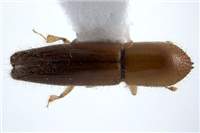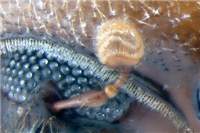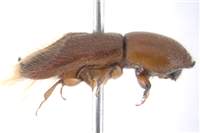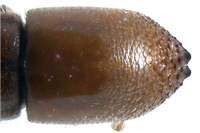Diagnosis
Often peculiarly elongated and very pale-colored body. Pronotum distinctly elongated, with long paired serration on the anterior margin, pronotal sides emarginate. Elytral declivity with spines and/or tubercules, often with conspicuously long and dense setae. Antennal club flattened with the first and second sutures moderately to slightly procurved and the first two segments sclerotized.
Distribution
Neotropical, most species very rare.
Biology
Sampsonius are domicile parasites and do not excavate their own galleries. Instead the female locates the newly excavated gallery of another ambrosia beetle, often as a Dryocetoides species, enters the gallery and consumes the original inhabitant. The Sampsonius female then uses the gallery to raise her brood. Species are usually found in seedlings or branches from 2-8 cm in diameter.
Taxonomy
Monophyletic (Hulcr et al. 2007).
Detailed description
Eyes shallowly emarginated, upper portion of eyes smaller than the lower part. Antennal club approximately circular, club type four (not truncated, 1st segment anteriad smaller than 2nd, both convex). Segment 1 of club straight (may be slightly concave or convex) on the anterior face, its margin mostly costate and may appear softer on posterior face. Segment 2 of club corneous on both sides of club, but not circular (not making antenna tall, or telescopic. Segment 3 of club clearly visible on both sides of the club. Segment 1 of antennal funicle shorter than pedicel, funicle 4-segmented. Scapus regularly thick. Frons above epistoma mostly smooth, alutaceous, with minor punctures or rugged and coarsely punctate. Submentum flat flush with genae, shaped as a narrow triangle. Anterior edge of pronotum with two distinct flat denticles protruding anteriad, whole margin extends anteriad forming distinct hood over head. Pronotum from lateral view anterior part long (type 9). From dorsal view conspicuously long, angulate or rounded frontally (type b). Pronotal disc shining or smoothly alutaceous, with small punctures, lateral edge of pronotum obliquely costate. Procoxae contiguous, prosternal posterocoxal process short and conical, or flat and inconspicuous. Tuft on pronotal basis associated with mesonotal mycangium absent, setae on elytral bases associated with elytral mycangium also absent. Tuft on pronotal basis associated with mesonotal mycangium absent, setae on elytral bases associated with elytral mycangium also absent. Scutellum flat, flush with elytra. Elytral bases straight, with oblique edge, elytral disc longer than declivity, and convex or bulging, punctures on elytral disc in strial lines (which may be difficult to discern). Boundary between elytral disc and declivity distinct. Lateral profile of elytral declivity excavated, dorsal profile of elytral apex prolonged apically, attenuated or angulate or concave, emarginate. Elytral declivity covered with dense erect setae, often more abundant than strial punctures. Posterolateral declivital costa elevated reaching beyond fifth interstriae, often completely surrounding the whole declivity. Surface of declivity with a pair of tubercles on elevated costa around declivity, their assignment to interstriae is difficult or a pair of long projections, one on each elytron. First interstriae parallel (sometimes slightly broadened towards elytral summit). Striae and interstria on the upper part of declivity even, flush with the surface. Protibia slender, not distinctly flat. Posterior side of protibia flat, with setae only. Protibial denticles small, bases of denticles slightly elevated protibial margin rounded, fewer than 6 protibial denticles present. Metatibia of normal size. Color uniformly light brown or reddish (pronotum sometimes slightly lighter). Length: 3.1 8.0 mm.






